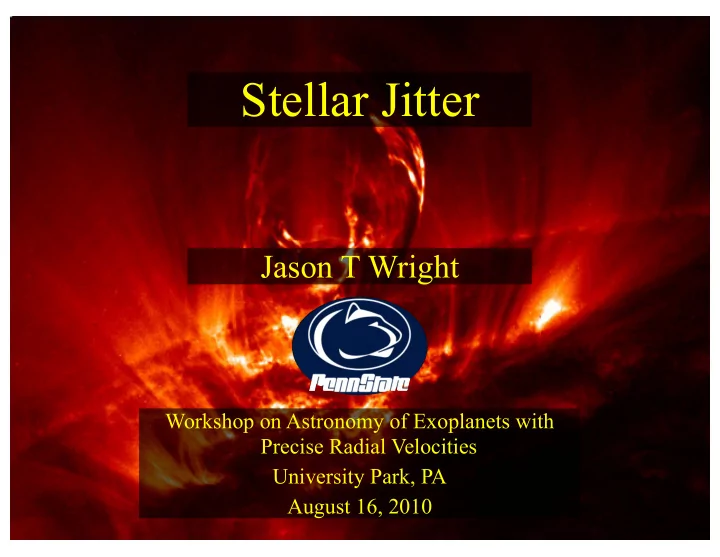

Stellar Jitter Jason T Wright Workshop on Astronomy of Exoplanets with Precise Radial Velocities University Park, PA August 16, 2010 1
Velocity and velocity variations correlate with chromospheric activity 2 Campbell et al. (1991)
Velocity and velocity variations correlate with chromospheric activity 3 Campbell et al. (1991)
Jitter is short-term, non-COM variation in measured radial velocity Jitter increases with: • Instrument systematics (non-astrophysical) } Stellar Youth • Chromospheric activity • Rotation • Stellar mass • Post-main sequence evolution 4
Some options for dealing with jitter • Avoidance: Focus on old, inactive late-G and K dwarfs • Mitigation: treat the asteroseismology (see Gilliland) • Mitigation: correlate with photometry (see Walkowicz) • Beat it down: Many observations (if possible) • “Direct detection”: bisectors (see Boisse) • See also: Santos, Dumusque 5
Jitter increases strongly with stellar activity After Wright (2005) 6
Jitter increases with evolutionary state 7 Johnson et al. (2010)
Jitter increases with evolutionary state Hekker et al. (2008) 8
Jitter increases with stellar mass and rotation speed Saar, Butler, & Marcy (1998) 9
Jitter increases with stellar mass and rotation speed Galland et al. (2005) 10
Jitter can be incoherent and has many timescales • Rotationally modulated spots (days-weeks) • Other rotationally modulated features (days-weeks) • Flares, CMEs, and other violent events (minutes-days) • p-modes (asteroseismology) • active longitudes (years) 11
Rotationally modulated spots can masquerade as planets HD 166435; Queloz et al. (2001) 12
Jitter can be estimated from similar “stable” stars or included as a free parameter Gregory (2005) Jitter Ford (2005); Ford (2006)
Some possible sources of long term RV-activity correlation • Net convective blueshift varies with global B field strength • Starspots/plage produce line asymmetries • Others... (see Makarov) 14 see, e.g., Saar & Donahue (1997)
Long-term velocity-activity correlations have been predicted ADS 15
Long-term velocity-activity correlations may be seen Walker et al. (1995) 16
Long-term velocity-activity correlations may be seen 17 Deming et al. (1997)
Long-term velocity-activity correlations may be seen 18
Most stars do NOT show activity CYCLE correlations with velocity Wright et al. (2009) 19
Most stars do NOT show activity CYCLE correlations with velocity Wright et al. (2009) 20
HD 154345 -- conspiracy of periods 30 Velocity (S � <S>)*1000 20 Velocity (m/s) 10 0 � 10 � 20 1998 2000 2002 2004 2006 2008 2010 Date
HD 154345 -- conspiracy of periods 30 Velocity (S � <S>)*1000 20 Velocity (m/s) 10 0 � 10 � 20 1998 2000 2002 2004 2006 2008 2010 Date
HD 154345 -- conspiracy of periods?!? 30 Velocity (S � <S>)*1000 20 Velocity (m/s) 10 0 � 10 � 20 1998 2000 2002 2004 2006 2008 2010 Date
Jupiter-analogs WITHOUT cycles H D 13931 P = 11 . 5 y r M a ss = 1 . 88 M J UP / s i n i K = 23 . 3 m s − 1 20 e = 0 . 017 Ve l o c i t y ( m s − 1 ) 0 − 20 − 40 R M S = 3 . 31 m s − 1 1998 2000 2002 2004 2006 2008 2010 T i m e ( Yea r s )
Jupiter-analogs WITHOUT cycles 0.158 0.156 S 0.154 0.152 2004 2006 2008 2010 2012 Date
Activity cycles masquerading as planets • Long-term S-RV correlations rare, but not unknown • Difficult, but not impossible to distinguish • A few other examples known, but not as clear • Contemporaneous activity meas./photometry essential! • Implications for: • K-giant planets? (e.g. Hekker (2008)) • eps Eridani?
Summary • Jitter is short-term, non-COM variation in measured radial velocity • Jitter increases strongly with stellar activity, stellar mass, evolution, and rotation speed • Jitter can be incoherent and has many timescales • Rotationally modulated spots can masquerade as planets • Jitter can be estimated from similar “stable” stars to a factor of ~2 or included as a free parameter in orbital fits • Long-term velocity-activity correlations have been predicted and seen, but are rare among quiet stars
Recommend
More recommend